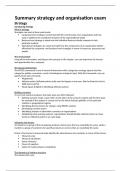Summary strategy and organisation exam
Strategy
Introducing strategy
What is strategy
Strategies can exist at three main levels:
Corporate-level strategy is concerned with the overall scope of an organisation and how
value is added to the constituent business of the organisational whole
Business-level strategy is about how the individual business should compete in their
particular markets
Operational strategies are concerned with how the components of an organisation deliver
effectively the corporate- and business-level strategies in terms of resources, processes and
people.
The environment
Using all the information, techniques and concepts in this chapter, you can determine the threats
and opportunities for a company.
The macro-environment
The PESTEL framework is one of several frameworks which categorises strategy aspects into five
categories: politics, economics, social, technological, ecological, legal. With this framework, you can
specify three types of trends:
Megatrends
Inflexion points (inflexion points really need to happen in one year, like the financial crisis in
2008 and covid-19)
Weak signals (helpful in identifying inflexion points)
Building scenarios
To carry out scenario analyses, five basic steps are often followed:
Defining scenario scope: scope refers to the place of the scenario analysis and the time span,
for example if the analysis is carried out for the whole industry globally, or for particular
markets or geographical regions
Identifying the key drivers for change: using PESTEL analysis
Developing scenario stories
Identifying impacts of alternative scenarios on organisations
Establishing early warning systems: organisations should identify indicators that can show
trends or inflection points in an early stage
Industries and sectors
An industry is a group of firms producing products and services that are essentially the same, while a
market is a group of customers for specific products or services that are essentially the same.
Porter’s Five Forces Framework helps identify the attractiveness of an industry in terms of five forces:
Threat of entry
Threat of substitutes
Power of buyers
Power of suppliers
Extent of rivalry between competitors
The dynamics of industry structure
The industry life cycle:
, Name Market size Characteristics What’s important?
Development Very small Low rivalry Innovation
Growth Quite small Low rivalry, high growth Growth ability
Shake-out Quite high Increasing rivalry, some exits Managerial and
financial strength
Maturity High Stronger buyers, low growth Market share and cost
Decline Quite high, but Extreme rivalry, many exits and price Cost and commitment
decreasing competition
Competitors and markets
Within a competition or market, there can be differences. Hyundai and Porsche, both in the car
industry, will have different barriers to entry and competitive moves by one are unlikely to affect the
other. There usually are strategic groups, which are groups with organisations within an industry with
similar strategic characteristics. But there can also be a difference between two companies on the
demand side, so on the customer needs; a market segment is a group of customers with similar
needs, different from customer needs in other parts of the market.
It’s important to do a competitor analysis, for which you can use two models. First, the strategy
canvas, showing for each competitor how well they are performing on some parts. Second, the ‘Blue
Oceans’. This model looks to Blue Oceans, which are new market spaces where competition is
minimised and Red Oceans, where rivalry is intense.
Strategic capabilities
Using all the information, techniques and concepts in this chapter, you can determine the strengths
and weaknesses for a company.
Foundations of strategic capability
There are different types of capabilities:
Strategic capabilities are the capabilities of an organisation that contribute to its long-term
survival or competitive advantage. Strategic capabilities are resources (what we have) and
competences (what we do well).
Dynamic capabilities are capabilities a company needs to be able to renew and recreate its
strategic capabilities to meet the needs of changing environments.
Threshold capabilities are about keeping your position and making sure to meet the
necessary requirements to compete in a given market. Without them, an organisation could
not survive over time.
Distinctive capabilities are required to achieve competitive advantage
VRIO strategic capabilities as a basis of competitive advantage
With VRIO, you can determine the competitive advantage of your strategic capabilities:
Value: strategic capabilities are valuable when they create a product or service that is of
value to customers. Besides, they MUST generate higher revenues or lower costs (or both)
Rarity: rare capabilities are unique, or just a few organisations have them
Inimitability: inimitable capabilities are difficult or expensive to imitate or substitute
Organisational support: the organisation must be suitably organised to support the
capabilities
Diagnosing strategic capabilities
The value chain describes the categories of activities of an organisation which, together, create a
product or service. There are two types of activities in the value chain:






